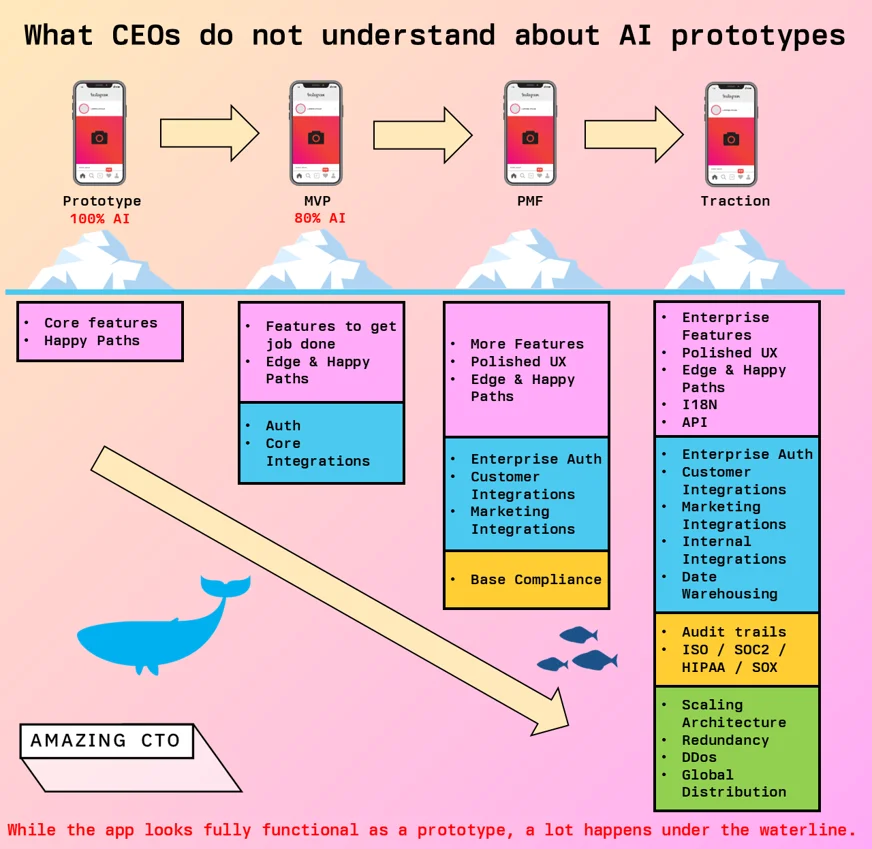Stephan Schmidt - September 21, 2025
AI - What CEO's often get wrong about prototypes
Prototypes are not the same as production code
TL;DR: AI can rapidly generate prototypes, but production-ready products require exponentially more work—including error handling, security, compliance, integrations, and scalability—making AI-assisted development slower and more complex as products mature. CTOs must educate CEOs that while AI excels at prototypes (the visible tip of the iceberg), the underlying infrastructure for production systems still demands significant human expertise and time.
I hear from CTOs that they struggle with AI in many ways.
One way is the pressure put up by many CEOs because of their insufficient understanding of AI in the product development process.
“With AI a prototype takes a day to create, why does it take a month to put it into production?” Often CEOs see the speed with which prototypes can be build with an LLM, either agentic or augmented, and demand the those going to production.
This is an incarnation of the iceberg problem. Those CEOs only see the tip of the iceberg, the UI, and think that is all there is. They can’t see below the surface - this is where you, the CTO comes in.
My product life cycle model contains:
- Prototype - validate idea
- MVP - validate customer need
- PMF - validate customer demand
- Traction - validate market demand
A product goes through these stages to reach maturity. Each of those stages add specific code to make that stage work. At each stage the size of the product increases and complexity increases too.

Prototype
- The happy path of features to show off the idea
MVP
- Features to make the app useful for clients
- Many more features than the prototype
- All error paths and edge cases
- Authentication and Authorization
- Core customer integrations
PMF
- More features to PMF and reduce churn
- Polished UI
- Enterprise auth
- Customer integrations
- Marketing integrations
- Basic GDPR compliance
Traction
- All in PMF
- Enterprise features
- I18N
- API
- Internal integrations
- Audit trails
- Data warehousing
- ISO/ SOC2/ SOX/ HIPAA/ GDPR/ CCPA/ compliance
- Scaling architecture
- Redundancy
- DDos protection
- Global distribution
Im each step, the functionality and the amount of code might more than double or triple. Something small and modest becomes a behemoth.
This takes time to develop. And every brick you add to the wall, makes it more difficult to add more bricks. Think of it like reverse-Jenga. So more and more care needs to be taken to add new features. This slows development down - because every new feature needs to work with the existing feature set. Adding a form with data needs to be GDPR compliant. As CTO, you need to help CEOs understand how this core principle of software development works and how it relates to AI. The prototype is easy, production code that scales is not.
The more code there is, the more difficult it is to use and AI to make it work. While the prototype (currently, 2025) can be 100% AI generated, this is not possible yet for PMF stage applications.
FAQ: AI, Prototypes, and Product Development
Q: Can AI build a full production-ready product? A: As of 2025, AI can generate impressive prototypes and simple applications. However, building a robust, scalable, and compliant product for real customers still requires significant human expertise, especially as complexity grows.
Q: Why does development slow down as the product matures? A: Each new feature must integrate with all existing features, comply with regulations, and maintain quality. The more code and features, the more care and time are needed to ensure everything works together.
Q: Is it a good idea to use AI for prototyping? A: Yes! AI excels at quickly generating prototypes to validate ideas. This can save time and help teams iterate faster in the early stages.
Q: What are the main challenges of using AI for later product stages? A: Later stages require handling edge cases, security, compliance, scalability, and integrations—areas with interlocking complexity and where current AI tools are limited by their context and human oversight is essential.
Q: How should CTOs explain this to CEOs? A: Emphasize that while AI accelerates early development, building a reliable, compliant, and scalable product is a different challenge. The “iceberg” analogy: the visible prototype is just the tip; the real work lies beneath the surface.
About me: Hey, I'm Stephan, I help CTOs with Coaching, with 40+ years of software development and 25+ years of engineering management experience. I've coached and mentored 80+ CTOs and founders. I've founded 3 startups. 1 nice exit. I help CTOs and engineering leaders grow, scale their teams, gain clarity, lead with confidence and navigate the challenges of fast-growing companies.
